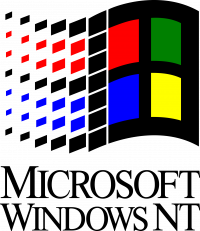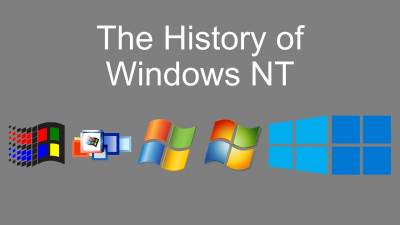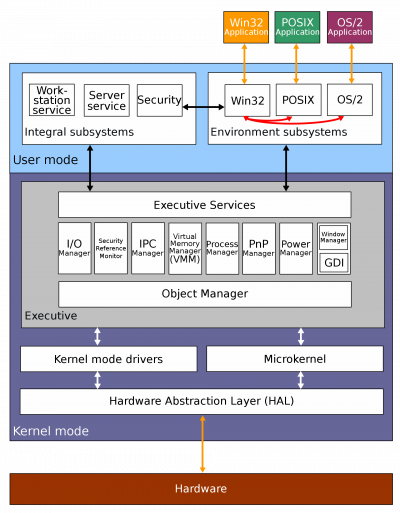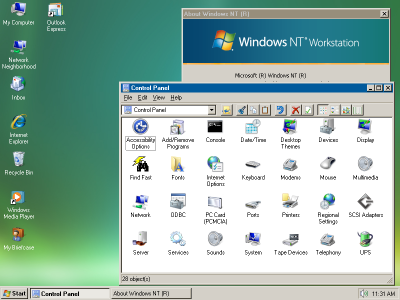Table of Contents
What is Windows NT ?
Windows NT is a proprietary graphical operating system produced by Microsoft, the first version of which was released on July 27, 1993. It is a processor-independent, multiprocessing and multi-user operating system.
The first version of Windows NT was Windows NT 3.1 and was produced for workstations and server computers. It was a commercially focused operating system intended to complement consumer versions of Windows that were based on MS-DOS (including Windows 1.0 through Windows 3.1x). Gradually, the Windows NT family was expanded into Microsoft's general-purpose operating system product line for all personal computers, deprecating the Windows 9x family.
“NT” was formerly expanded to “New Technology” but no longer carries any specific meaning. Starting with Windows 2000, “NT” was removed from the product name and is only included in the product version string along with several low-level places within the system. In fact, NT was a trademark of Northern Telecom (later Nortel) at the time, which Microsoft was forced to acknowledge on the product packaging.
NT was the first purely 32-bit version of Windows, whereas its consumer-oriented counterparts, Windows 3.1x and Windows 9x, were 16-bit/32-bit hybrids. It is a multi-architecture operating system. Initially, it supported several instruction set architectures, including IA-32, MIPS, and DEC Alpha; support for PowerPC, Itanium, x64, and ARM were added later. The latest versions support x86 (including IA-32 and x64) and ARM. Major features of the Windows NT family include Windows Shell, Windows API, Native API, Active Directory, Group Policy, Hardware Abstraction Layer, NTFS, BitLocker, Windows Store, Windows Update, and Hyper-V.
Versions of Windows NT are installed using Windows Setup, which, starting with Windows Vista, uses the Windows Preinstallation Environment, which is a lightweight version of Windows NT made for deployment of the operating system.
History
Microsoft decided to create a portable operating system, compatible with OS/2 and POSIX and supporting multiprocessing, in October 1988. When development started in November 1989, Windows NT was to be known as OS/2 3.0, the third version of the operating system developed jointly by Microsoft and IBM. To ensure portability, initial development was targeted at the Intel i860XR RISC processor, switching to the MIPS R3000 in late 1989, and then the Intel i386 in 1990. Microsoft also continued parallel development of the DOS-based and less resource-demanding Windows environment, resulting in the release of Windows 3.0 in May 1990.
Windows 3.0 was eventually so successful that Microsoft decided to change the primary application programming interface for the still unreleased NT OS/2 (as it was then known) from an extended OS/2 API to an extended Windows API. This decision caused tension between Microsoft and IBM and the collaboration ultimately fell apart.
IBM continued OS/2 development alone while Microsoft continued work on the newly renamed Windows NT. Though neither operating system would immediately be as popular as Microsoft's MS-DOS or Windows products, Windows NT would eventually be far more successful than OS/2.
Microsoft hired a group of developers from Digital Equipment Corporation led by Dave Cutler to build Windows NT, and many elements of the design reflect earlier DEC experience with Cutler's VMS, VAXELN and RSX-11, but also an unreleased object-based operating system developed by Cutler at Digital codenamed MICA. The team was joined by selected members of the disbanded OS/2 team, including Moshe Dunie.
The VMS kernel was primarily written in VAX MACRO, but Windows NT was designed to run on multiple instruction set architectures and multiple hardware platforms within each architecture. The platform dependencies are hidden from the rest of the system by the HAL (Hardware Abstraction Layer).
While creating Windows NT, Microsoft developers rewrote VMS in C. Although they added the Win32 API, NTFS file system, GUI, and backwards compatibility with DOS, OS/2, and Win16, DEC engineers almost immediately noticed the two operating systems' internal similarities; parts of VAX/VMS Internals and Data Structures, published by Digital Press, accurately describe Windows NT internals using VMS terms. Instead of a lawsuit, Microsoft agreed to pay DEC $65–100 million, help market VMS, train Digital personnel on Windows NT, and continue Windows NT support for the DEC Alpha.
Windows NT and VMS memory management, processes, and scheduling are very similar. Windows NT's process management differs by implementing threading, which DEC did not implement until VMS 7.0 in 1995, likely to compete with Microsoft.
Like VMS, Windows NT's kernel mode code distinguishes between the “kernel”, whose primary purpose is to implement processor- and architecture-dependent functions, and the “executive”. This was designed as a modified microkernel, as the Windows NT kernel was influenced by the Mach microkernel developed by Richard Rashid at Carnegie Mellon University, but does not meet all of the criteria of a pure microkernel. Both the kernel and the executive are linked together into the single loaded module ntoskrnl.exe; from outside this module, there is little distinction between the kernel and the executive. Routines from each are directly accessible, as for example from kernel-mode device drivers.
API sets in the Windows NT family are implemented as subsystems atop the publicly undocumented “native” API; this allowed the late adoption of the Windows API (into the Win32 subsystem). Windows NT was one of the earliest operating systems to use Unicode internally
It has been suggested that Dave Cutler intended the initialism “WNT” as a play on VMS, incrementing each letter by one. However, the project was originally intended as a follow-on to 2 and was referred to as “NT OS/2” before receiving the Windows brand. One of the original NT developers, Mark Lucovsky, states that the name was taken from the original target processor—the Intel i860, code-named N10 (“N-Ten”). A 1998 question-and-answer (Q&A) session with Bill Gates revealed that the letters were previously expanded to “New Technology” but no longer carry any specific meaning. The letters were dropped from the names of releases from Windows 2000 and later, though Microsoft described that product as being “Built on NT Technology”.
Windows NT 3.51
Enhancements
Taskbar for Windows NT 3.51
Happen to have a Windows NT 3.51 installation? Ever wanted it to look a bit more modern or simply want a different GUI (graphics user interface)? NewShell2 will enhance the interface of NT 3.51's Windows 3.1 theme! The interface will instead look more like Windows NT 4.0. NewShell2 is a bug-fixed version of the original NewShell, which served as an alpha-test version of the NT 4 shell. You can now give your NT 3.51 the design it was intended to have!
Features:
- Taskbar GUI for Windows NT 3.51
- NT4 interface for Windows NT 3.51
- Easy GUI navigation
- Bug fixes for original buggy NewShell
Requirements:
- Windows NT 3.51
Instructions:
- Unzip
- Install!
Windows NT 4.0
Enhancements
NT 4 Enchancement Pack
The NT4 Enhancement Pack by awergh provides a fresh new glimpse at the NT operating system. Simply improve the aesthetics NT4 and its shell with a simple click. Once installation is done, behold yourself for some eye-candy! Vista icons everywhere along with updated graphics now in NT! Enjoy the semi-new look.
Features:
- Updated System, Tray, Dialog, and many Application icons
- Updated Printer Wizard
- Network Dialog
- Proxy Login Dialog
- Logon Screensaver
- Tahooma Font included
Requirements:
- Windows NT4 Workstation Service Pack 6a or Server [Terminal Server untested]
- Video card capable of 32-bit color
Recommended:
- Internet Explorer 6
- Windows Media Player 7
Instructions:
- Unzip appropriate edition.
- Run executable.
- Enjoy!





